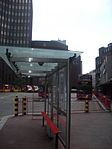Church of Holy Trinity, Minories
13th-century establishments in England1941 disestablishments in EnglandChurches bombed by the Luftwaffe in LondonDestroyed churches in LondonFormer Royal Peculiars ... and 3 more
Former buildings and structures in the London Borough of Tower HamletsFormer churches in LondonReligion in the London Borough of Tower Hamlets

Holy Trinity, Minories, was a Church of England parish church outside the eastern boundaries of the City of London, but within the Liberties of the Tower of London. The liberty was incorporated in the Metropolitan Borough of Stepney in 1899, and today is within the City of London. Converted from the chapel of a nunnery, Holy Trinity was in use as a church from the 16th century until the end of the 19th century. It survived as a parish hall until it was destroyed by bombing during World War II.
Excerpt from the Wikipedia article Church of Holy Trinity, Minories (License: CC BY-SA 3.0, Authors, Images).Church of Holy Trinity, Minories
St Clare Street, City of London
Geographical coordinates (GPS) Address Nearby Places Show on map
Geographical coordinates (GPS)
| Latitude | Longitude |
|---|---|
| N 51.512647 ° | E -0.074632 ° |
Address
St Clare Street 9
EC3N 1LQ City of London
England, United Kingdom
Open on Google Maps










